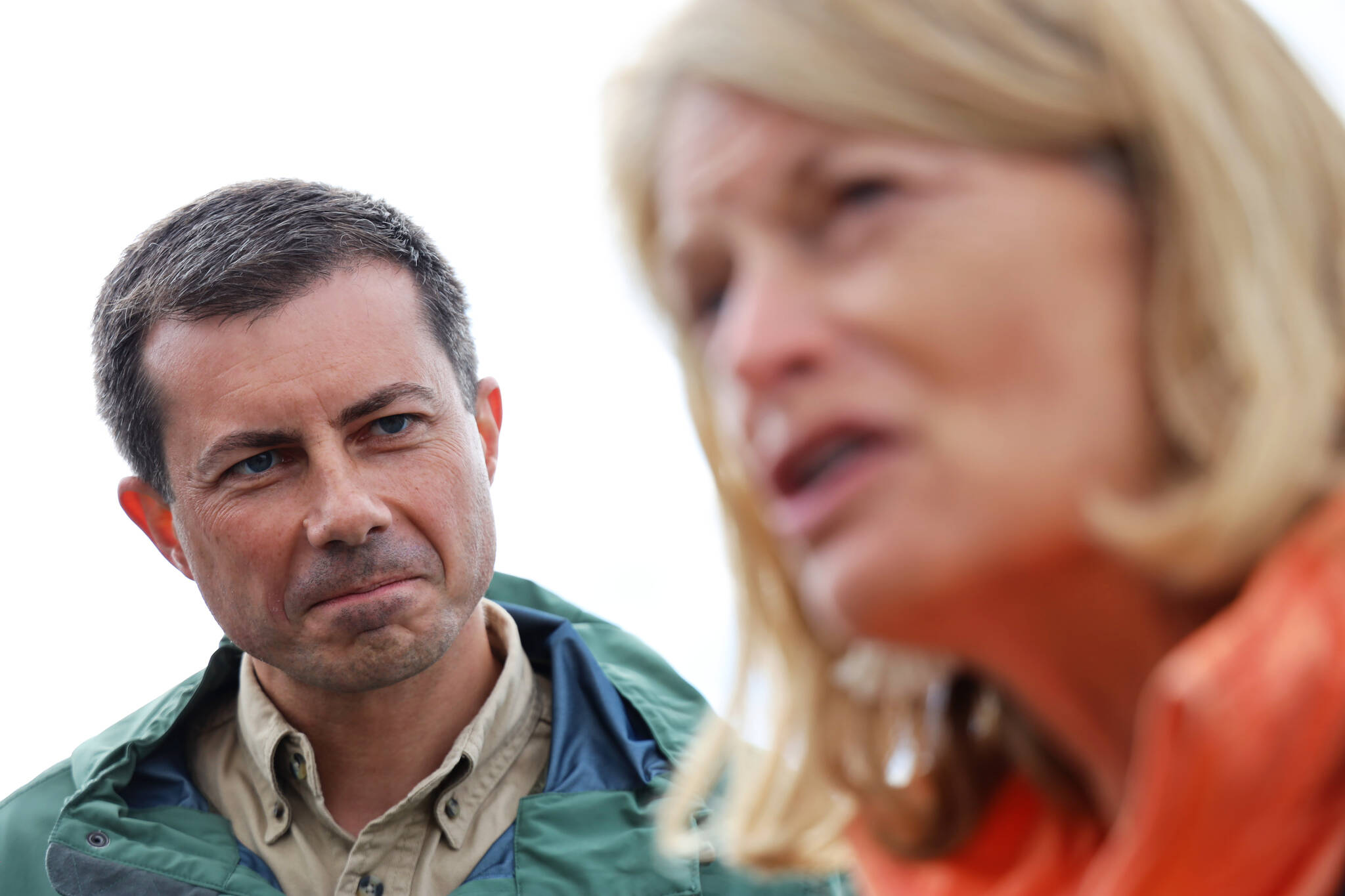An earlier version of this article incorrectly stated Buttigieg visited Skagway. Travel disruptions meant that portion of the scheduled trip was cancelled.
After two days of hearing about how increasingly extreme weather and environmental forces are disrupting Alaska’s transportation and infrastructure, U.S. Transportation Secretary Pete Buttigieg got a first-hand sampling of it during a visit to Southeast Alaska on Wednesday that ended with a delayed stop in Juneau.
Buttigieg, on the last day of his Alaska trip, made a brief media appearance on the tarmac at Juneau International Airport after exiting a small plane that came back from a tour in Haines with U.S. Sen. Lisa Murkowski. Their arrival was delayed, along with many of the day’s plans, after they had to take a five-hour ferry trip to Haines because poor weather grounded their scheduled Alaska Seaplanes flight from Juneau earlier in the morning.
“We got the whole spectrum in one day,” he said about experiencing some of the challenges many people face when traveling in Southeast Alaska.
Buttigieg’s tour came as the state is expected to receive more than $5 billion in funding from the Bipartisan Infrastructure Law passed by Congress in 2021. Some of those funds include $285 million for a large-scale overhaul of Alaska Marine Highway System vessels and facilities, $14 million for new and restored cabins in the Tongass and Chugach national forests, nearly $3.5 million for Juneau International Airport, and $280,000 for a city Safe Streets 4 All program.
[Feds float AMHS $285M in ferry infrastructure funding]
During the trip, Buttigieg announced the U.S. Department of Transportation Maritime Administration’s designation of a new marine highway route named M-11. The route is set to add more than 6,500 miles of what the federal government officially categorizes as marine highways, and includes coastal and river ports in southwestern and northern Alaska from the Aleutian Islands to the Canadian border. It’s essentially a northern extension of AMHS’ existing M-5AK route.
“The waterways of the Bering Sea, Bristol Bay, the Arctic Ocean, and the Yukon-Kuskokwim River Delta have been waterborne transportation hubs for centuries,” a DOT announcement Wednesday stated. “Many communities in this area depend on a system of ports, rivers, barge landings, and airports for the movement of goods and passengers. The M-11 Route will enhance transportation in these communities and will provide a greater range of waterborne transportation choices.”
Buttigieg said the designation means greater access to grant funding and policy attention.
“Something we’re really trying to have a national conversation about, in addition to our highway system (is that) we’ve got our interstate highway system and we’ve got our marine highway system. We got I-95, we got M-95. Nowhere is that more visibly important than in Alaska.”
Buttigieg said the process of deciding the new route was rigorous with “quite a few wickets to get through.”
“We want to make sure that this is a designation that matches the conditions on the ground, the needs and also our readiness to support them,” he said.
Buttigieg said it needed to be able to fit into the national vision of the policy framework, while also being eligible for various funding opportunities in the future. He said it fits into a bigger picture of the future of the AMHS.
“Down the line, as Congress introduces programs or expands programs, they can incorporate by reference that entire class of waterways — whether we’re talking about river passages in the Midwest, or those coastal passages that are part of the Alaska designation — and say, ‘these are all part of what qualifies because we’ve already laid out what that means.’”
Throughout the trip he met with various tribal entities and leaders such as the Chilkoot Indian Association, Chilkat Indian Village, Central Council of the Tlingit and Haida Indian Tribes of Alaska, and the Alaska Federation of Natives.
Buttigieg’s talk with the press was followed by a closed-door meeting with local officials, including City and Borough of Juneau Mayor Beth Weldon, to talk about the Juneau Airport’s infrastructure.
• Contact reporter Clarise Larson at clarise.larson@juneauempire.com or (651) 528-1807.

